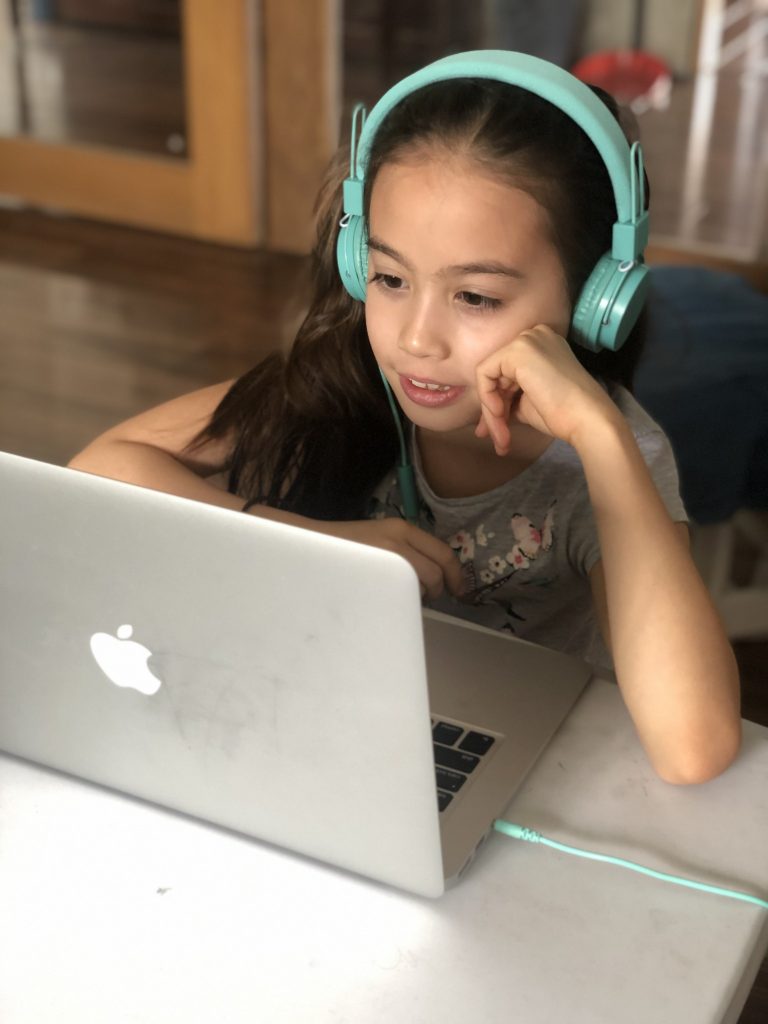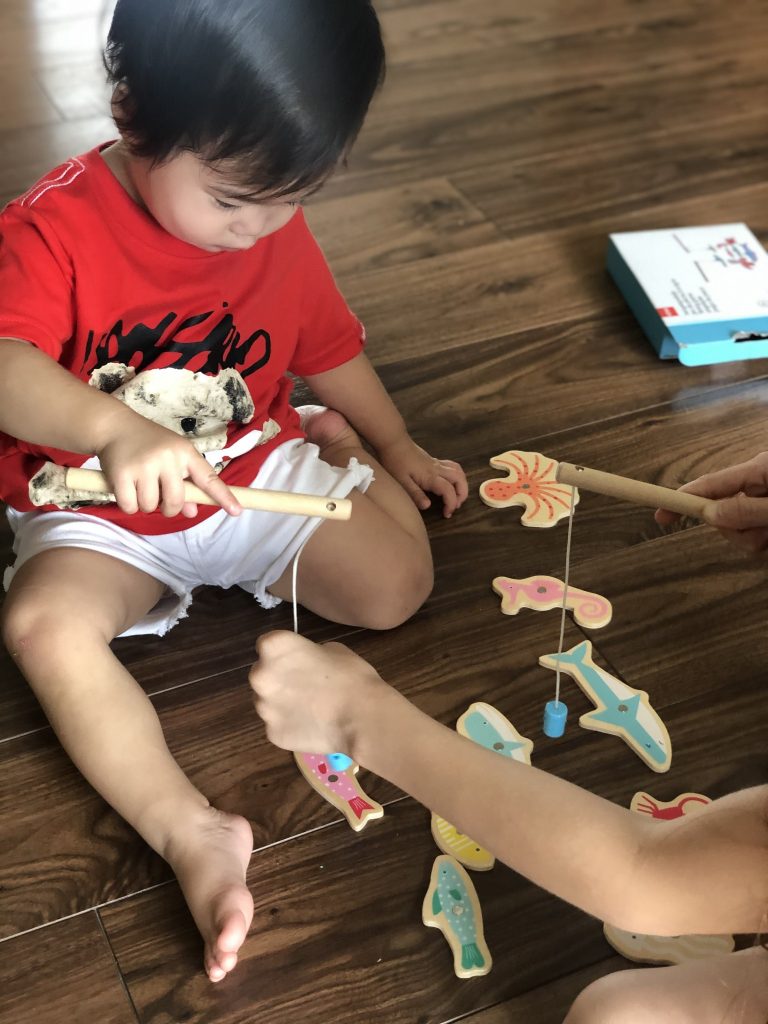Screen-based learning is becoming an important tool for teaching young children (ages 0 to 6) foundational concepts and skills, but it’s effect on the way children learn in real life is not widely researched. There is greater emphasis on general screen-usage and recommended exposure time, and an accommodating posture towards high-quality programming. According to the American Psychological Association (2019), children between 0 to 18 months should avoid screen-time; children between 18 and 24 months can have minimal high-quality programming with the presence of an adult, and children between 2 and 5 can have up to one hour of daily high-quality programming.

For the purposes of this paper, I will refer to high-quality programming as visually stimulating content that is educational in nature (promotes early literacy, numeracy, and social skills) and appropriate to the age level of a child, as opposed to shows, games or apps that don’t have value beyond entertainment. Screen-time or screen-use will refer to time spent on any device with a screen, such as televisions, smartphones, laptops or computers, video game consoles, and tablets.
The Common Sense Census on the use of media of children ages 0 to 8 reports that “the average amount of time spent with mobile devices each day has tripled (again), going from 5 minutes a day in 2011 to 15 minutes a day in 2013 to 48 minutes a day in 2017. Overall, children 8 and under spend an average of about two-and-a-quarter hours (2:19) a day with screen media, up from 1:55 in 2013” (Rideout, 2017, p.3). This data is pre-Covid-19 and pre-quarantine, which means that the time spent on screens could be significantly higher. According to parents whose young children use screen media, 67 percent of them claim that it is helping their children learn (a lot or a little), and 57 percent say it’s helping their creativity, too (Rideout, 2017, p.3). Unicef suggests that the internet can be a critical tool for children’s access to play, entertainment, social interaction, and learning, and people should view this as something positive during this pandemic (Winther, 2020).
Even though high-quality programming appears to have promising results, this article proposes that it overstimulates young children in order replicate the effectivity of in-person, hands-on, and whole body learning, which conditions them to prefer a screen in order to learn and affects their ability to focus.
Since the quarantine season due to Covid-19 has placed an extra burden on parents to keep their kids productive and busy while at home, and most people believe that high-quality, screen-based learning is a good option, this research will compel them to consider the cost. If screen-based, high quality educational experiences negatively affect young children’s desire to engage in reading, creating, or socializing with others in real life, then screen-use during these ages, even for educational programming, might have to be avoided.
First, young children are hard-wired to learn from others, not screens. They pick-up content and understand it best when an adult engages them, as well as when they can use their entire bodies to learn. As pioneering Cyberpsychologist, Mary Aiken, asserts in her book, The Cyber Efect. “The evidence is irrefutable: The best way to help a baby learn to talk or develop any other cognitive skill is through live interaction with another human being” (p. 97). Even if children may learn from educational programming, “the effectiveness of interactive devices with infants and toddlers may still rely on parent scaffolding to help children understand how information on a screen relates to real life” (Courage, 2016). A young child remains dependent upon an adult who can dialogue with and explain to them what’s happening on the screen, as well as make sense of it.

Second, children learn with their bodies, when their senses are maximized. Screens cannot match the sensorial learning experience of a child turning a page, being able to put a book or toy in their mouths and feel it with their tongues, handling objects with fingers, smelling the familiar or new scents around them, and sitting on a parent’s lap or beside her while being read to and played with. Allyson Bowcutt explains that “traditional books are still more appropriate for babies, because children in these stages learn ‘through their bodies’” (p. 108). An article by Science Daily, discusses how babies need to be challenged and stimulated as soon as they are born by involving their body and senses in exploration of their environment and various materials inside and outside of the home, in all kinds of situations and climates (NTNU, 2017). Research on neuroplasticity by Duncan Banks (2016) reveals that an infant develops neural connections through visual, auditory, tactile, smell, and motor stimuli.
When a child is placed in front of a screen to learn, the stimulation offered by the educational programming has to be heightened to imitate the effectiveness of in-person, hands-on, whole body learning. However, this results in over-stimulation. Take for instance, the widely popular, CoComelon, with over 91 million followers and over 74 billion views, which targets children ages 0 to 6 years old. CoComelon, like other videos, sites, apps, or games that offer high-quality programs, is designed to keep young children riveted and hooked on to the screen with their characters, imagery, sounds, and elements. Alexis Madrigal, who authored the article, “Raised by YouTube” for The Atlantic (2018), interviewed co-creators of CoComelon, Chief Creative Officer, B.M. Krishnan and CEO, Vinoth Chandar, of ChuChu TV who “believe that any given shot needs to include many different things a child could notice: A bird flying in the background. Something wiggling. These things hold kids’ attention.” Madrigal goes on to explain that “ChuChu and other companies like it—whatever their larger philosophy—can see exactly what holds a toddler’s attention, moment by moment, and what causes it to drift” relying on YouTube analytics to identify when a child loses interest in their videos so they can make appropriate changes and upgrades.
The stimulation that is designed to encourage learning in young children conditions them to desire and prefer the same levels of stimulation in order to be engaged in a learning experience. It is not the content that is of concern but the manner in which the content being taught is communicated on a screen. “The formal features of the medium are what present a risk, thereby making even potentially educational programming detrimental, not because of the content but because it overstimulates too many senses for too long too early in development” (Christakis, Ramirez, Ferguson, et al, 2018, p. 115). “Children who watch more television develop the ability to learn from it and are not hard-wired to attend to a live person better than a screen…There is also evidence that children who use a lot of screen media relative to their peers actually develop a preference for video learning versus in person learning (Becker, 2013, p. 27).
Ironically, the hyper stimulation that makes children concentrate on a screen leads to difficulty focusing and distractedness. Dr. Jim Taylor writes in Psychology Today, that, historically speaking, when children were engaged in the process of reading they had to concentrate, use their imagination, and commit what they were reading to memory. When television came along, it offered stimulation that left little need for imagination. Then the Internet happened, which immersed children in an environment where it was the norm to be distracted, where imagination was no longer essential, and where memory was impaired (2012). Pediatrician and researcher, Dimitri Christakis, delivered his “overstimulation hypothesis” during a TEDx Talk, warning that prolonged exposure of a child to rapid image changes during this critical window of development conditions him to expect the same levels of stimulation, thereby leading to inattentiveness later in life” (As cited in Huddleston, 2016, p. 105). What makes educational programming exciting and engaging actually distracts them from learning (Aiken, 2017, p. 105).
In conclusion, screen-based learning over-stimulates young children in order to match the effectivity of in-person, hands-on, and whole-body learning, which conditions them to prefer being in front of a screen in order to learn and affects their ability to focus. Nevertheless, there are limitations to these conclusions. It’s not clear at what point screen-based learning becomes overstimulating for young children, or how much time it takes before the overstimulation reaches a point of concern. It’s also hard to determine which high-quality programs are more detrimental to focus and concentration than others since individual studies would have to be done on each one. Furthermore, this paper focuses on ages 0 – 6 when it can be narrowed down further to a specific stage such as infancy. Lastly, because it’s proven that children learn from sensorial experiences, it may be possible for them to benefit from certain types of screen-based learning that encourages more physical interaction and requires parental participation and engagement in order to achieve the learning objectives of the educational lesson or program.
References
Aiken, M. (2017) The Cyber Effect. London, England: John Murray Publishers.
American Psychological Association. (2019, December 12). Digital guidelines: Promoting healthy technology use for children. Retrieved from http://www.apa.org/topics/healthy-technology-use-children
Banks, D. (2016, April 5). What is Brain Plasticity and Why Is it so Important?. Retrieved from https://theconversation.com/what-is-brain-plasticity-and-why-is-it-so-important-55967
Becker, L. (2013). The effects of screen media exposure on children’s word learning. (Master’s Thesis, University of Colorado, Boulder, USA). Retrieved from https://scholar.colorado.edu/honr_theses/395
Bowcutt, A. (2013) Discovering the e-relationship between babies and early e-Literacy: A case study on the responses of babies aged 0-12 to traditional texts and electronic readers. (Doctor’s Thesis, Ohio State University, Columbus, USA). Retrieved from https://etd.ohiolink.edu/
Christakis, D., Ramirez, J., Ferguson, S., Ravinder, S., & Ramirez, JM. (2018, October) How early media exposure may affect cognitive function: A review of results from observations in humans and experiments in mice. Proceedings of the National Academy of Sciences, 115 (40) 9851-9858; DOI: 10.1073/pnas.1711548115
Courage, M., PhD, & Troseth, G., PhD. (2016, November). Infants, toddlers and learning from screen media. The effects of screen media exposure on children’s word learning. Encyclopedia on Early Childhood Development. Retrieved from http://www.child-encyclopedia.com/technology-early-childhood-education/according-experts/infants-toddlers-and-learning-screen-media
Huddleston, B. (2016). Digital cocaine—A journey toward iBalance. Vereeniging, RSA: Christian Art Publishers.
Madrigal, A. (2018, November). Raised by youtube. The Atlantic Magazine. Retrieved from https://www.theatlantic.com/magazine/archive/2018/11/raised-by-youtube/570838
Rideout, V. (2017). The Common Sense census: Media use by kids age zero to eight. San Francisco, CA: Common Sense Media.
Taylor, J. PhD. (2012, December 4). How technology is changing the way children think and focus. Psychology Today. Retrieved from https://www.psychologytoday.com/us/blog/the-power-prime/201212/how-technology-is-changing-the-way-children-think-and-focus
The Norwegian University of Science and Technology (NTNU). (2017, January 2). Babies exposed to stimulation get brain boost. Science Daily. Retrieved from www.sciencedaily.com/releases/2017/01/170102143458.htm
Winther, D. (2020, April 7). Re-thinking screen time in the time of covid-19. Retrieved from https://www.unicef.org/globalinsight/stories/rethinking-screen-time-time-covid-19


Thanks for finally writing about > Screen-based Learning and
Its Effect on Real Life Learning in Young Children | Teach With Joy < Liked it!
I have been exploring for a little bit for any high-quality articles or weblog posts on this kind of area
. Exploring in Yahoo I finally stumbled upon this site. Studying this info
So i’m glad to express that I have an incredibly
excellent uncanny feeling I came upon just what I needed.
I such a lot undoubtedly will make certain to don?t
disregard this site and give it a glance on a constant basis.
Its such as you read my thoughts! You seem to know a lot about this,
such as you wrote the ebook in it or something. I think that you could do with some percent to pressure the message house a bit, but instead of that, that is wonderful blog.
A great read. I will certainly be back.
An impressive share! I’ve just forwarded this onto a co-worker who was doing
a little research on this. And he in fact bought me
dinner due to the fact that I found it for him… lol. So allow me to reword this….
Thank YOU for the meal!! But yeah, thanx for spending the time to
talk about this topic here on your website.
That is very attention-grabbing, You are an excessively skilled
blogger. I’ve joined your feed and sit up for searching
for extra of your fantastic post. Additionally, I’ve shared
your site in my social networks
Highly descriptive article, I liked that a lot.
Will there be a part 2?
Just wish to say your article is as astounding.
The clarity on your put up is simply nice and that i can think you’re a professional in this subject.
Well together with your permission let me to grab your feed to keep up to
date with forthcoming post. Thanks a million and please carry on the
gratifying work.
Keep on working, great job!
These are genuinely impressive ideas in about blogging.
You have touched some good points here. Any
way keep up wrinting.
I am sure this article has touched all the internet viewers, its really really fastidious post on building up new webpage.
Actually when someone doesn’t be aware of then its
up to other users that they will help, so here it occurs.
Hello There. I found your blog using msn. This is an extremely well written article.
I will be sure to bookmark it and come back to read more of your useful info.
Thanks for the post. I will definitely return.
I’m no longer certain the place you’re getting your information, but great topic.
I needs to spend a while studying more or working out more.
Thanks for wonderful info I used to be in search of this information for my mission.
I came here after discovering your bio dad and reading about your story. I am doubly inspired now. I am a teacher and instructional designer in the U.S. These ideas that you write about have been on my mind for the past year as I continue to explore and plan for its long-term implications.
Many people use their lotteries to raise money for valuable initiatives that improve education,
general public infrastructure and interpersonal services. When the lottery will be performed
by you, you’re assisting to finance these programs while you account
your own ambitions of winning it big. Have a
great time and good luck!
Thank you a bunch for sharing this with all of us you actually realize what you are talking about!
Bookmarked. Please additionally visit my web site =).
We may have a hyperlink change contract between us
Appreciate it. Plenty of facts!